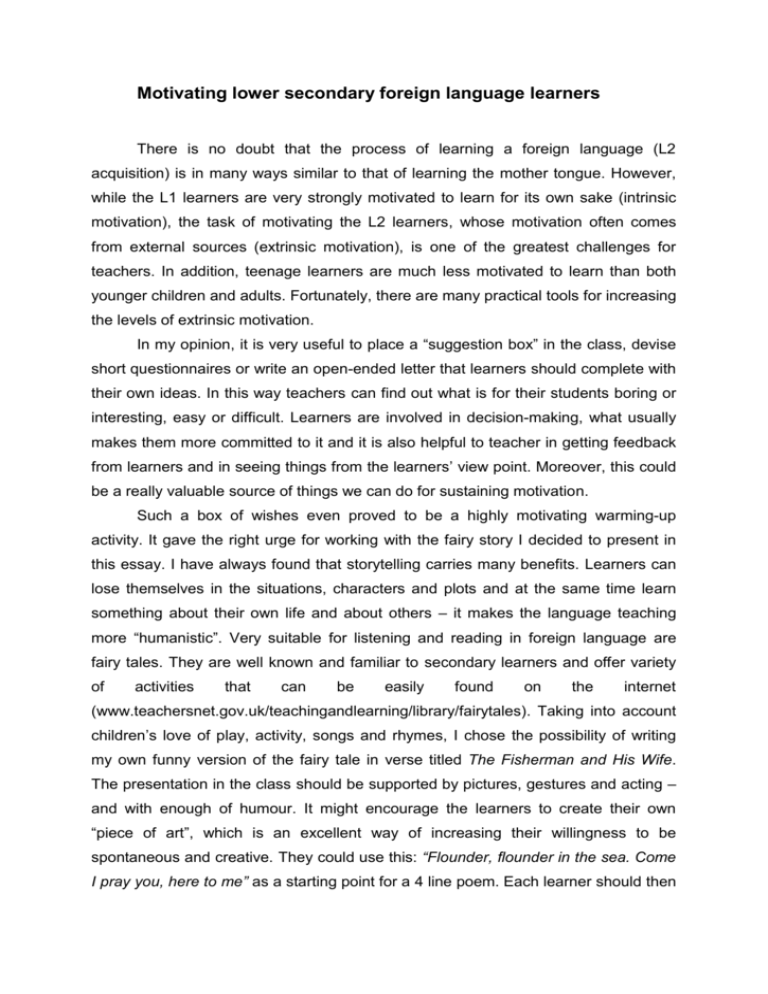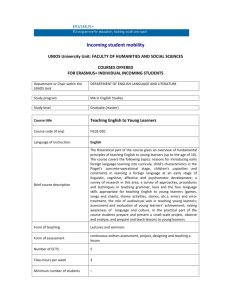Motivating lower secondary foreign language learners
advertisement

Motivating lower secondary foreign language learners There is no doubt that the process of learning a foreign language (L2 acquisition) is in many ways similar to that of learning the mother tongue. However, while the L1 learners are very strongly motivated to learn for its own sake (intrinsic motivation), the task of motivating the L2 learners, whose motivation often comes from external sources (extrinsic motivation), is one of the greatest challenges for teachers. In addition, teenage learners are much less motivated to learn than both younger children and adults. Fortunately, there are many practical tools for increasing the levels of extrinsic motivation. In my opinion, it is very useful to place a “suggestion box” in the class, devise short questionnaires or write an open-ended letter that learners should complete with their own ideas. In this way teachers can find out what is for their students boring or interesting, easy or difficult. Learners are involved in decision-making, what usually makes them more committed to it and it is also helpful to teacher in getting feedback from learners and in seeing things from the learners’ view point. Moreover, this could be a really valuable source of things we can do for sustaining motivation. Such a box of wishes even proved to be a highly motivating warming-up activity. It gave the right urge for working with the fairy story I decided to present in this essay. I have always found that storytelling carries many benefits. Learners can lose themselves in the situations, characters and plots and at the same time learn something about their own life and about others – it makes the language teaching more “humanistic”. Very suitable for listening and reading in foreign language are fairy tales. They are well known and familiar to secondary learners and offer variety of activities that can be easily found on the internet (www.teachersnet.gov.uk/teachingandlearning/library/fairytales). Taking into account children’s love of play, activity, songs and rhymes, I chose the possibility of writing my own funny version of the fairy tale in verse titled The Fisherman and His Wife. The presentation in the class should be supported by pictures, gestures and acting – and with enough of humour. It might encourage the learners to create their own “piece of art”, which is an excellent way of increasing their willingness to be spontaneous and creative. They could use this: “Flounder, flounder in the sea. Come I pray you, here to me” as a starting point for a 4 line poem. Each learner should then memorize his/her poem and recite it “on stage” in front of the class. This activity could even lead to role playing. For that matter I recommend the rewritten Jazz Chants Fairy Tales by Carolyn Graham with general suggestions for practising specific grammar and pronunciation patterns and also ideas for presenting the fairy tale. Each fairy tale has a narrator, several major roles and a chorus so that all learners can participate in each performance. All roles are open to all English learners despite language level or appearance. The group can also spend time making props and costumes. In The Fisherman and His Wife, the chorus members can divide into various kind of sea creatures such as dolphins, sharks, or mermaids and create headbands to represent those characters. In the end the learners perform their play for other classes and for their parents, who surely appreciate seeing their children speaking in English. If the students feel comfortable with it the performance could be recorded and used again in class afterwards. The whole process from listening, writing, practising and performing sets the learners a “larger” task and gives them the opportunity to demonstrate other skills in the language classroom. Although it may be a little nerve-wracking, it is really worth the trouble. Most foreign language learners depend greatly on their teachers to motivate them. Without sufficient motivation long-term goals can’t be accomplished. So teachers should find out ways to create situations to make learners become more motivated. There is one teaching and learning resource which is unlimited: the human mind and imagination, fortunately. Sources: http://www.teachingenglish.org.uk/think/methodology/visualisation.shtml Puchta, H. and Schratz, M.: Teaching Teenagers. Longman 1993. Graham, C.: Jazz Chants Fairy Tales. Oxford University Press 1988. Čestné prohlášení Prohlašuji, že jsem tuto seminární práci vypracovala samostatně a s použitím uvedených zdrojù. Mgr. Petra Křížová J. Hradec, 15.2.2008







